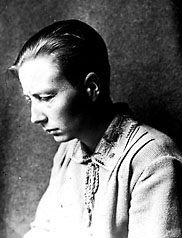Grete Hermann facts for kids
Quick facts for kids
Grete Hermann
|
|
|---|---|

Grete Hermann
|
|
| Born | 2 March 1901 |
| Died | 15 April 1984 (aged 83) Bremen, West Germany
|
| Nationality | German |
| Education | University of Göttingen (Ph.D., 1926, adv. Emmy Noether) |
| Occupation | Mathematician and philosopher |
| Employer | Assistant for Leonard Nelson; professor for philosophy and physics at the |
Grete Hermann (born March 2, 1901 – died April 15, 1984) was a brilliant German mathematician and philosopher. She was known for her important work in mathematics, physics, philosophy, and education.
Grete Hermann is especially famous for her early ideas about quantum mechanics, which is a branch of physics that studies very tiny particles. She also wrote an important paper that pointed out a mistake in a famous physics theory. This paper was not well-known for many years. Some people think that if her ideas had been noticed earlier, the history of quantum mechanics might have been very different!
Contents
Grete Hermann's Work in Mathematics
Grete Hermann studied mathematics at Göttingen University with famous professors like Emmy Noether. She earned her Ph.D. (a high-level degree) in 1926.
Her Ph.D. paper was called "The Question of Finitely Many Steps in Polynomial Ideal Theory." This paper was very important for a field called computer algebra. It was one of the first papers to show that there are specific steps, or algorithms, to solve many basic problems in abstract algebra. Her work is still used today in computer programs that deal with math.
Working with Leonard Nelson
From 1925 to 1927, Grete Hermann worked as an assistant for Leonard Nelson, who was a philosopher. After Nelson passed away, she helped publish his writings on philosophy and education. At the same time, she continued her own research.
Her Ideas on Quantum Mechanics
As a philosopher, Grete Hermann was very interested in the basic ideas of physics. In 1934, she went to Leipzig to try and connect older ideas about cause and effect with the new quantum mechanics theory.
In Leipzig, she had many discussions with other famous scientists like Carl Friedrich von Weizsäcker and Werner Heisenberg. She wrote about her ideas, focusing on the difference between being able to predict something and understanding its cause.
From Denmark, she published her important work called The foundations of quantum mechanics in the philosophy of nature. This book is considered one of the first and best philosophical discussions of quantum mechanics. In it, she wrote:
The theory of quantum mechanics forces us […] to drop the assumption of the absolute character of knowledge about nature, and to deal with the principle of causality independently of this assumption. Quantum mechanics has therefore not contradicted the law of causality at all, but has clarified it and has removed from it other principles which are not necessarily connected to it.
—Grete Hermann, The foundations of quantum mechanics in the philosophy of nature
This means she believed quantum mechanics didn't go against the idea of cause and effect. Instead, it helped us understand it better. In June 1936, she even won an award for her work.
Her Critique of John von Neumann's Theory
In 1935, Grete Hermann wrote about a famous proof by John von Neumann. His proof seemed to show that a "hidden variable theory" in quantum mechanics was impossible. A hidden variable theory suggests there are secret factors that determine how tiny particles behave, even if we can't see them.
Grete Hermann's work on this topic was not noticed by many scientists for a long time. It was only much later, in 1966, that another scientist, John Stewart Bell, discovered similar ideas. Then, in 1974, Max Jammer pointed out that Grete Hermann had found this problem much earlier. Some people believe that if her ideas had been known sooner, it might have changed how scientists understood quantum mechanics.
Political Activism
When Adolf Hitler and the Nazis came to power in Germany, Grete Hermann bravely joined an underground movement against them. She was a member of a group called the Internationaler Sozialistischer Kampfbund (ISK), which worked against the Nazi government.
Life in Other Countries and Later Years
By 1936, Grete Hermann had to leave Germany because of the political situation. She moved to Denmark, then to France, and finally to England. In London, she got married in 1938 to avoid drawing attention to herself as a German. This was a smart move because, a couple of years later, the British government started to view many people who had fled Germany with suspicion. Some were even placed in special camps.
After World War II ended in 1945, Grete Hermann could combine her love for physics and mathematics with her interest in political ideas. She returned to Germany in 1946 and rejoined the Social Democratic Party (SPD). She helped create an important plan for the party, which later helped them become part of the government in the 1960s.
She became a professor of philosophy and physics. She also played an important role in a teachers' union. From 1961 to 1978, she led an organization that focused on education, fairness in society, and responsible political actions. This organization was founded by her old friend, Leonard Nelson.
See also
 In Spanish: Grete Hermann para niños
In Spanish: Grete Hermann para niños

